
Holly Trees
Dive into the captivating world of holly trees, exploring their diverse species, unique characteristics, and ecological significance. Discover 21 exceptional holly tree species, each with its unique charm and contribution to our vibrant ecosystem
In the vast kingdom of flora, the genus Ilex, better known as holly, shines brightly with its varied species of trees and shrubs. Let us embark on an enlightening journey exploring 21 diverse species of this captivating genus.
1. Ilex Aquifolium: The English Holly

Ilex Aquifolium, or the English Holly, is renowned for its glossy evergreen leaves and bright red berries. Native to Western and Southern Europe, this species boasts a majestic height of up to 25 meters, making it a dominant figure in its natural habitat.
Ilex Aquifolium, commonly known as the English holly, is a tree or shrub found in Western Asia, North Africa, and Europe.
The plant is famous as an ornamental because of its glossy, spiny leaves and bright red berries. The English holly is also associated with Christmas traditions, as it is often used to make wreaths and decorations.
The wood of the English holly is hard and white and can be used for carving and turning. The leaves and berries of the English holly have medicinal properties, such as anti-inflammatory and diuretic effects.
However, they are also toxic to humans and animals if ingested in large quantities.
2. Ilex Opaca: American Holly

Ilex Opaca, known as the American Holly, is a beloved species in the United States. With a height that can reach up to 60 feet, the American Holly showcases strikingly spiked leaves and clusters of vibrant red berries.
Ilex Opaca, commonly known as American Holly, is a native of the eastern and central parts of the United States. The plant is widely cultivated for its glossy leaves and bright red berries, which attract birds and other wildlife.
American Holly is also used as a source of wood for furniture, musical instruments, and decorations. The leaves and berries have medicinal properties and were traditionally used by Native Americans for various ailments.
It is also the state tree of Delaware and the state symbol of Connecticut.
3. Ilex Cornuta: Chinese Holly
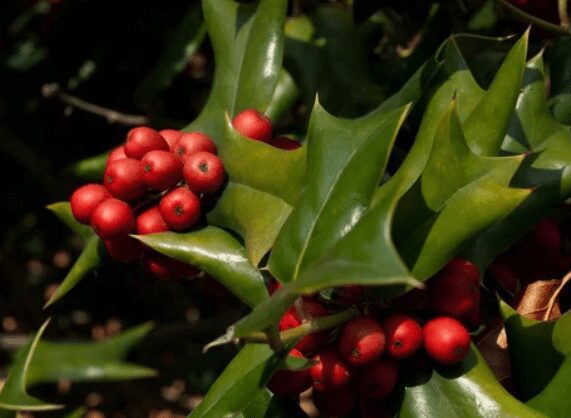
Ilex Cornuta: Chinese Holly is an evergreen shrub originating from Asia with distinctive horn-shaped leaves and small yellowish-green flowers. Growing up to 15 feet tall and wide, producing red, orange, or yellow berries attracts birds and other wildlife.
Chinese Holly is a hardy plant that can tolerate heat, drought, and various soil conditions, but it prefers moist and well-drained soil with acidic pH. Also resistant to some pests and diseases but may suffer from leaf miners, scale, whitefly, spider mites, powdery mildew, leaf spot, leaf rot, and tar spot.
Chinese Holly is a dioecious plant, meaning it has male and female flowers on different plants, and both sexes are needed to produce fruit. However, some cultivars, such as ‘Burford,’ can produce fruit without pollination.
It is a popular plant for landscaping purposes, as it can be used as a hedge, a screen, a specimen, or a foundation plant.
Ilex Cornuta has fragrant flowers that attract bees and other pollinators. However, it is considered invasive in some areas, such as Georgia, where it can escape cultivation and spread rapidly. Good to know that it is toxic to humans and pets if ingested.
4. Ilex Verticillata: Winterberry Holly
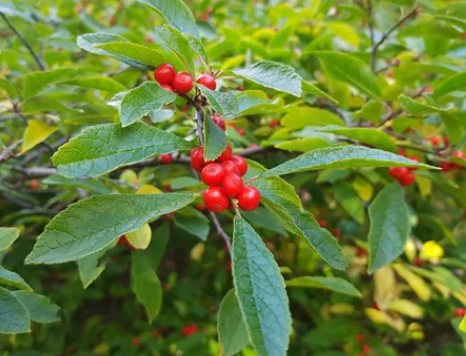
Winterberry Holly, or Ilex verticillata, is a North American holly species. The shrub grows up to 5 meters tall and produces bright red berries in late autumn and winter.
The berries are an essential food source for many birds and mammals but poisonous to humans and pets.
The leaves are dark green, oval-shaped, and have serrated edges. Segments of small, white flowers appear in late spring or early summer. The best-growing conditions for this plant are sunny or partially shaded and moist, acidic soil.
Wet conditions are not a problem, and it is often planted near ponds or streams. Winterberry Holly is a popular ornamental plant for its attractive foliage and berries, which add color and interest to the winter landscape.
You can prune it to maintain a desired shape and size or let it grow naturally. Pests and diseases do not harm it. Winterberry Holly is a hardy and versatile plant that can enhance any garden’s beauty and wildlife value.
5. Ilex Vomitoria: Yaupon Holly

Ilex Vomitoria, also known as Yaupon Holly, is a native plant of southeastern North America that belongs to the holly family Aquifoliaceae.
The plant grows as an evergreen shrub or tree up to 30 feet tall, with glossy green leaves with serrated edges and small white flowers blooming in spring. The female plants produce red or yellow berries, appealing to birds and other wildlife but toxic to humans and pets.
Ilex Vomitoria comes from the fact that some Native American tribes used the leaves to make a caffeinated drink that induced vomiting as part of their rituals.
However, the leaves can also be brewed into a mild tea that does not cause nausea and is similar to yerba mate. Yaupon Holly is a versatile and adaptable plant that can tolerate various soil types, moisture levels, pH levels, and sun exposures.
The plant is often used as a hedge, screen, or specimen plant in landscaping and has several cultivars with different shapes and sizes. Yaupon Holly is also resistant to most pests and diseases and can live up to 75 years.
6. Ilex Crenata: Japanese Holly
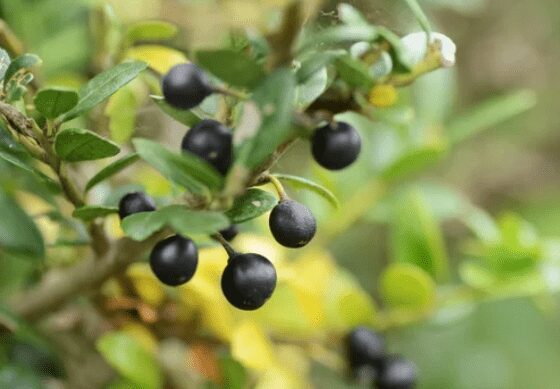
Ilex Crenata, also known as Japanese Holly, belongs to the family of evergreen shrubs native to Japan, Korea, and China. It belongs to the Aquifoliaceae family and has small, glossy green leaves and blackberries.
As an ornamental plant, it is commonly used in gardens and landscapes, as it can be pruned into various shapes and sizes. Ilex Crenata is hardy and adaptable but prefers moist, well-drained soil and partial shade.
Despite resistance to most pests and diseases, it may suffer from leaf spots and scale insects. Ilex Crenata can be propagated by seeds or cuttings and can live up to 50 years.
7. Ilex Paraguariensis: Yerba Mate

The Ilex Paraguariensis plant, also known as the Yerba Mate plant, is an evergreen shrub in subtropical South America that belongs to the holly family. The leaves of this plant contain caffeine and other compounds that have various health benefits.
Yerba Mate is traditionally consumed as a hot or cold infusion, similar to tea, by millions of people in Brazil, Paraguay, Uruguay, and Argentina.
Indigenous Guarani and Tupi peoples have long used yerba mate, who considered it a sacred and energizing drink. Yerba Mate can also be grown indoors as an ornamental plant, requiring warm and humid conditions and plenty of sunlight.
8. Ilex Altarejosensis

Ilex Altarejosensis, a species endemic to Spain, is admired for its evergreen leaves and solitary red fruits. Its rarity adds to its unique appeal.
Ilex Altarejosensis is a hybrid of two holly species, Ilex aquifolium and Ilex perado, first discovered in a garden in England. It is also known as Highclere holly or Ilex x altaclerensis.
The height of this evergreen shrub or small tree can reach 50 ft or 15 meters. Usually spineless or with few spines, the dark green leaves appear glossy.
It blooms in late spring, followed by orange to red berries in autumn. There is no doubt that these berries are attractive to birds and other wildlife, but they are toxic to humans and pets. Ilex Altarejosensis is hardy and tolerant of various soil types, sun exposure, and pollution.
In addition to being a specimen plant, it is also helpful as a hedge or screen. Among its awards is the Royal Horticultural Society’s Garden Merit.
9. Ilex Cassine: Dahoon Holly

Dahoon Holly, or Ilex Cassine, stands out with its narrow, lance-shaped leaves and clusters of brilliant red berries. Native to the southeastern United States, it thrives in wetland habitats.
Ilex Cassine, commonly known as Dahoon Holly, is indigenous to the southeastern United States and Caribbean islands. Growing up to 10 meters tall, it is an evergreen shrub or small tree.
It has glossy, dark green leaves with serrated margins and red berries that attract birds and other wildlife. The flowers are white, four-petaled, and appear in spring. Ilex Cassine is adaptable to various soil and moisture conditions and can tolerate salt spray and flooding.
The plant is often planted as an ornamental or for erosion control along streams and wetlands. Some Native American tribes use it as a source of nectar for honey production and as a traditional medicine.
10. Ilex Argentea: Silver Holly
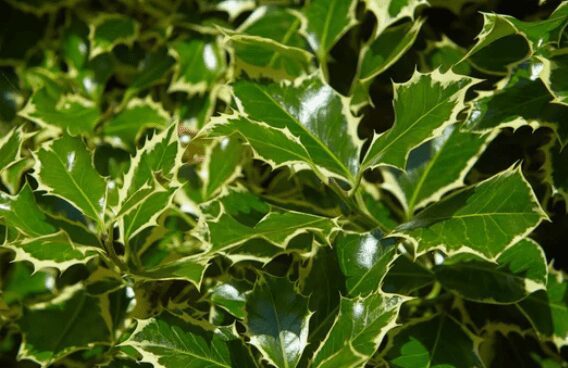
The Silver Holly, or Ilex Argentea, native to Malaysia, is a beautiful species recognized for its silver-tinged leaves.
Ilex argentea, commonly known as silver holly, is a species native to Japan and China. Generally speaking, it is a small evergreen tree that grows up to 10 meters tall. It has dark green leaves with silvery-white margins and spiny teeth.
If you want to see white flowers, springtime or summertime are the best times. A red berry ripens in autumn and persists into winter. Wildlife and birds find them attractive.
Silver holly is an ornamental plant for its variegated foliage and bright berries. Ideally, it needs moist, well-drained soil and partial shade. Some droughts and pollutants can be tolerated, but salt spray and alkaline soil cannot. USDA zone 6 is the range of hardiness for the plant.
It can be pruned to shape or trained as a hedge or topiary. Few pests or diseases affect it, but it may suffer from leaf spots, scale insects, or holly leaf miners.
Silver holly is a versatile and attractive plant that can add color and interest to any landscape. In addition to being used as a specimen, mixed borders, containers, and cut foliage, it can also be used as a cutting for arrangements. During the winter, birds and other animals use it as a food source.
11. Ilex Collina: Longstalk Holly

The Longstalk Holly or Ilex Collina is celebrated for its lush evergreen foliage, red berries, and unique long stalks, adding an unusual touch to the Holly family.
The Longstalk Holly, also known as Ilex Collina, is indigenous to the eastern United States. There are glossy green leaves with serrated edges on this deciduous shrub that grows up to 4 meters tall.
In late spring, white flowers appear, followed by red berries that persist into winter. These berries are attractive to birds and other wildlife but are poisonous to humans. Ilex Collina prefers moist, acidic soils and partial shade.
Plants such as this can be used as ornaments in gardens and landscapes or as a hedge or screen.
12. Ilex Dimorphophylla

Found primarily in Taiwan, Ilex Dimorphophylla shines with its small, rounded leaves and clusters of red berries.
Ilex dimorphophylla is a holly species native to Amami Ōshima, an island in the Ryukyu archipelago of Japan.
It grows as a compact shrub up to 6 feet tall, with glossy green leaves with spiny tips. In autumn, it produces small red berries that attract birds.
It is also known as Okinawa holly and is famous as a hedge plant or a bonsai specimen in Europe and North America.
13. Ilex Serrata: Finetooth Holly
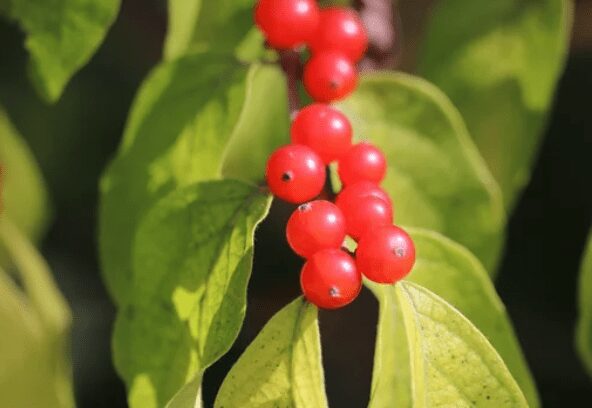
Originating in East Asia, the Finetooth Holly or Ilex Serrata is renowned for its finely serrated leaves and spherical red fruit.
Ilex serrata, also known as fine tooth holly, is a species of holly native to Japan and China. It is a deciduous shrub or small tree growing up to four meters tall. It has dark green, ovate leaves with serrated margins and prominent veins.
The flowers are pink and appear in spring, with bright red berries appearing in autumn and winter on the female plants. Birds and other wildlife enjoy the berries, but they are poisonous to humans.
Ilex serrata is often used as an ornamental plant in gardens, especially for its winter interest. A bonsai tree can also be grown from it, as it tolerates pruning well. Ilex serrata prefers moist, acidic, and organically rich soils and tolerates partial shade or full sun.
14. Ilex Genus: Myrtle Holly
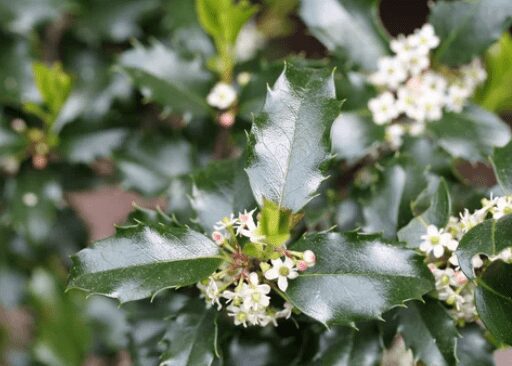
Myrtle Holly is an exciting species of holly, often characterized by its glossy green leaves, small white flowers, and vibrant red berries.
The Ilex genus is a group of around 480 flowering plants in the family Aquifoliaceae. They are commonly known as hollies or myrtles, and they are widely distributed in temperate and tropical regions of the world.
Hollies are evergreen or deciduous shrubs or trees with simple, often spiny leaves and small, white, or greenish flowers.
The fruits are usually red, orange, yellow, or black berries that contain four seeds. Hollies are popular ornamental plants for gardens and landscapes, and some species are also used for food, medicine, and wood.
15. Ilex X Attenuata: Foster’s Holly

A hybrid holly, the Foster’s Holly or Ilex X Attenuata, is esteemed for its pyramidal shape, spiny, dark green leaves, and bright red berries.
Ilex X Attenuata, also known as Foster’s Holly, is a hybrid of two holly species: Ilex Cassine and Ilex Opaca, a small evergreen tree with a height and width of up to 25 feet.
It has glossy dark green leaves with spiny margins and clusters of red berries that persist through winter. It is a popular ornamental plant for landscapes and gardens because of its attractive foliage, fruit, and shape.
The plant prefers moist, well-drained soil and full sun to partial shade. It is tolerant of drought, salt spray, and urban pollution. It is hardy in USDA zones 6 to 9.
16. Ilex Perado: Madeira Holly
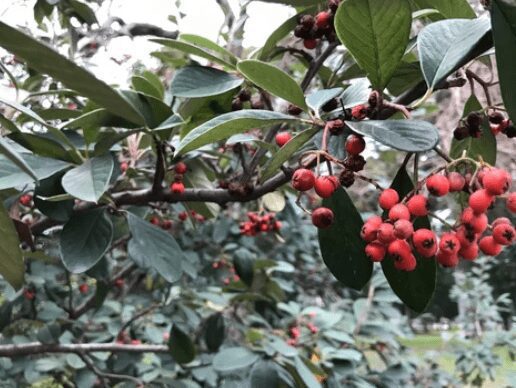
Ilex Perado, or the Madeira Holly, is native to the Atlantic Islands. It’s a standout species in its locale with shiny, spiny leaves and bright red berries.
Ilex Perado is a holly species found on Madeira and the Canary Islands islands. It is also known as Madeira Holly or Canary Island Holly. In addition to being a shrub, it can grow into a small tree, reaching up to 15 meters in height.
Small white flowers are accompanied by red berries in winter. The leaves are glossy, dark green with spiny margins.
It is an evergreen plant that prefers moist and shady habitats. Several gardens and parks cultivate it for ornamental purposes.
17. Ilex Krugiana: Krug’s Holly
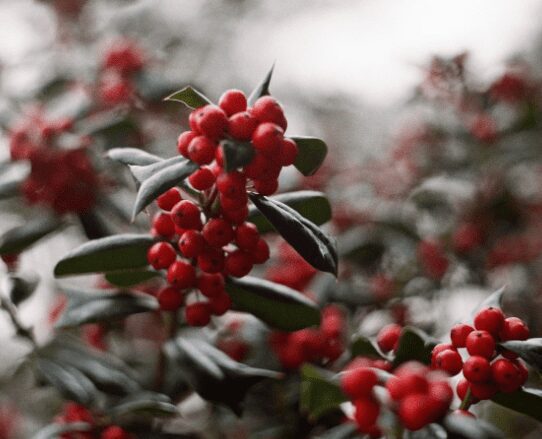
Endemic to Puerto Rico, Ilex Krugiana or Krug’s Holly, is a mountain-loving species known for its smooth-edged leaves and small red fruits.
Ilex Krugiana is a rare and threatened evergreen tree that belongs to the holly family (Aquifoliaceae). The species is also known as Krug’s Holly or Tawnyberry, in honor of Leopold Krug, a 19th-century German botanist who first described the species in South America.
Native to Florida and the Caribbean islands, it grows in rockland hammocks and pine rockland habitats. With elliptic leaves about two inches long, it has attractive foliage.
Pollination by bees occurs in spring when it produces white flowers. The flowers are dioecious, male or female, and occur on separate plants.
Birds eat the ripening blackberries in the fall. The tree can reach up to 55 feet in height and prefers moist, calcareous soil with a high pH. It can tolerate partial to full shade and some salt spray.
The fruit can be propagated by seeds that are de-pulped, cleaned, and planted right away after it is ripe. Place the seeds in a container with at least 2 inches of soil in partial shade.
The tree is suitable for landscaping as an understory or specimen tree. You can grow it in containers, along streets and sidewalks, or as a screening hedge.
The plant responds well to pruning. As a threatened tree in Florida, it should only be acquired from appropriately licensed sources.
18. Ilex Ampliceps
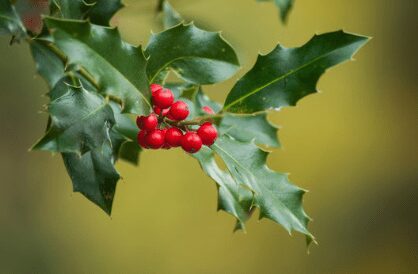
Originating from the high mountains of Taiwan, Ilex Ampliceps fascinates with its broad, leathery leaves and clusters of red berries.
Ilex Ampliceps is a holly species belonging to the Aquifoliaceae family, which contains over 570 species of flowering plants. It is native to China and Vietnam and grows in evergreen forests and limestone hills.
The height of a small tree or shrub can reach 10 meters. It bears small, white flowers and glossy, elliptic leaves in spring.
The fruits are red or black drupes that ripen in autumn and winter. Ilex Ampliceps is used in traditional medicine for treating coughs, asthma, rheumatism, and skin diseases.
19. Ilex Canariensis: Canary Island Holly

Canary Island Holly or Ilex Canariensis is a distinctive species native to the Canary Islands, boasting leathery, toothed leaves and small, apple-like fruits.
Ilex Canariensis, or Canary Island Holly, grows on the Canary Islands and Madeira. Ten meters is the maximum height of this evergreen tree.
It has glossy, dark green leaves with spiny margins and small white flowers that produce red berries in winter. A beautiful ornamental plant is also used for screening and hedging in gardens and parks.
Soil should be moist, well-drained, and full sun or partial shade is preferred. It can withstand some frost up to zone 9.
20. Ilex Cyrtura: Mochima Holly

The Mochima Holly, or Ilex Cyrtura, is a unique species from Venezuela, notable for its leathery leaves and brightly colored red fruits.
Ilex Cyrtura is a species of holly that belongs to the family Aquifoliaceae. High-altitude temperate forests in Bhutan, southern China, and northern Myanmar are home to this plant.
A deciduous or evergreen tree with spiny leaves, white flowers, and red berries. It was first described by Elmer Drew Merrill in 1921.
The Chinese word mo qi ma means holly, giving rise to Mochima Holly.
21. The Eagleston Holly

The Eagleston Holly is a hybrid of two native holly species: the Dahoon Holly and the American Holly. It is an evergreen shrub or small tree with a pyramidal shape and a dense canopy of bright green leaves. The leaves have soft spines and are glossy and smooth.
The Eagleston Holly produces small white flowers in spring and round red berries in fall. The berries attract birds and other wildlife to the garden.
The Eagleston Holly is adaptable to various soil types and pH levels as long as they are well-drained. It prefers full or partial sun and can somewhat tolerate drought and cold.
It is also resistant to common pests and diseases that affect other hollies. The Eagleston Holly can be used as a privacy screen, a hedge, or a specimen plant in the landscape. It can be pruned to maintain a desired shape and size or left to grow naturally.
It can reach up to 25 feet tall and 20 feet wide when mature. The Eagleston Holly is a low-maintenance and attractive plant that adds year-round interest and color to the garden.
Conclusion
Our expedition through the world of Holly has only just skimmed the surface of this fascinating genus. Each species holds a unique charm, beckoning further exploration into their captivating world.
The world of holly trees and shrubs is an ecosystem filled with diversity, elegance, and unique attributes.
These 20 species, from the glossy-leaved English Holly to the vibrant Mochima Holly, each contribute distinct features and values to their native habitats.
Their ubiquity, adaptability, and distinctive beauty make them cherished entities within our global ecosystem.
As we continue to explore and understand these species, it is clear that holly trees and shrubs offer aesthetic appeal and rich ecological significance.
Whether they adorn our landscapes, provide habitat for fauna, or become a source of cultural rituals, holly trees, and shrubs unquestionably enrich our world.




























